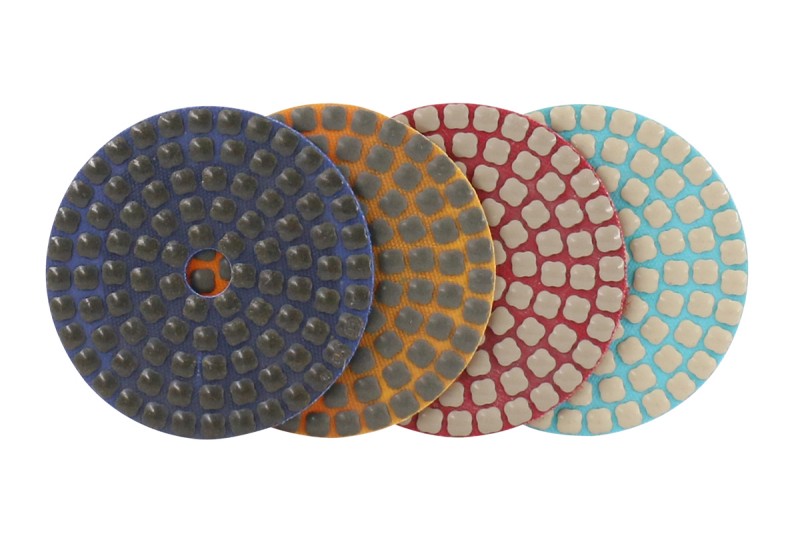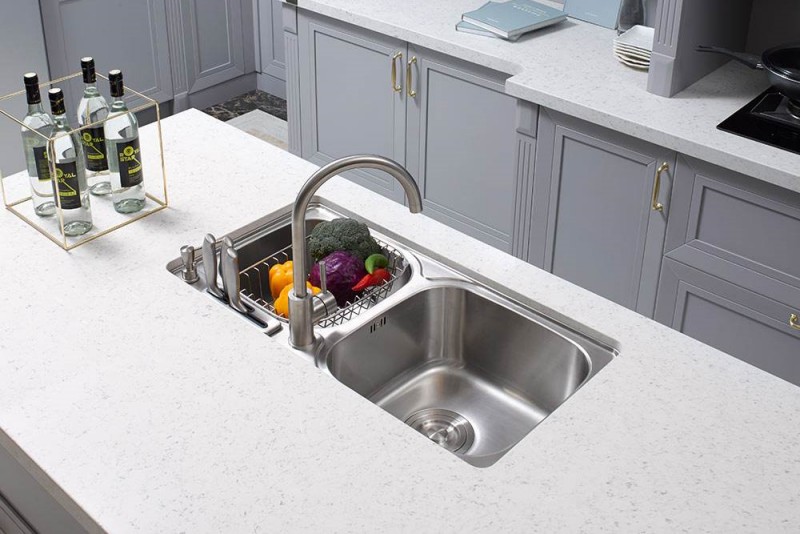Polishing countertops made of materials such as marble, granite or engineered stone is essential to maintaining their beauty and extending their life. The right polishing pad plays a vital role in achieving a high-quality polish.
The Importance of Polishing Pads
Polishing pads are designed to refine the surface of countertops, removing scratches, stains and blemishes while enhancing the natural sheen of the stone. The choice of a polishing pad directly affects the outcome of the polishing process. Using the right polishing pad can help achieve a smooth, shiny finish without damaging the surface.

Choose the Right Polishing Pad
1. Sand grain number:
The grit number of a polishing pad indicates how coarse or fine it is. Generally speaking, for countertop polishing, it is recommended to use a polishing pad with a grit number between 2000 and 3000. Here is a breakdown of grit numbers and their applications:
- Coarse grit (50-400): For heavy grinding and removing deep scratches or blemishes. Not suitable for final polishing.
- Medium grit (800-1500): Ideal for smoothing surfaces after initial grinding. This grit size prepares the surface for a finer polish.
- Fine grit (2000-3000): These pads are perfect for achieving a high gloss finish. They refine the surface and enhance the gloss without causing damage.
2. Material compatibility:
Different countertop materials may require specific types of polishing pads. For example:
- Marble: Marble is softer than granite and can be effectively polished with a finer polishing pad to avoid scratching.
- Granite: Requires a more aggressive pad initially, but can also benefit from a finer pad to achieve a polished finish.
- Artificial stone: Similar to granite, but always check the manufacturer's recommendations for best results.
3. Generate heat:
Polishing pads with higher grit (e.g. 3000) are more fragile and will generate heat during the polishing process. Excessive heat may damage the surface or the polishing pad itself. To mitigate this:
- Use water: Wet polishing can help reduce heat build-up and increase the effectiveness of your polishing pad.
- Medium pressure: Apply even, moderate pressure while polishing to prevent overheating.
4. Polishing technology:
The technique you use when polishing is just as important as the choice of polishing pad. Here are some tips:
- Start with a coarser pad: If the surface has noticeable scratches or blemishes, start with a coarser pad and gradually move to a finer pad.
- Use overlapping passes: When polishing, make overlapping passes to ensure even coverage and avoid missing spots.
- Check progress frequently: Check the surface regularly to ensure you are achieving the desired effect without over-polishing.
Polishing Pad Countertop Material Requirements

1. Quartz
Material properties:
Quartz countertops are artificial stone surfaces made from a mix of natural quartz crystals and resin. Quartz countertops are known for their high hardness and durability, making them resistant to scratches and stains.
Polishing pad requirements:
- Grit range: For quartz, it is generally recommended to use polishing pads with a grit between 1500 and 3000. This range allows for effective polishing without damaging the surface.
- Higher grit options: If a finer finish is required, higher numbered polishing pads (3000 and up) can be used for a finer grind and to achieve a high gloss finish.
Application tips:
- Use 1500 grit sandpaper first to remove any minor imperfections, then use 3000 grit sandpaper to achieve a smooth polished surface.
- Always use water or polishing compound to reduce heat and enhance the polishing process.
2. Marble
Material properties:
Marble is a softer natural stone known for its elegant appearance and unique veining. However, marble is more susceptible to scratching and corrosion than harder materials.
Polishing pad requirements:
- Grit range: For common types of marble, such as white, black or glossy finishes, polishing pads with a grit of 2000 to 3000 are ideal for achieving a beautiful shine.
- Higher grit options: If you plan on cleaning or disassembling your countertops, consider using a higher numbered polishing pad (3000+) for a more refined result.
Application tips:
- Use a 2000 grit polishing pad first to address any surface imperfections, then use a 3000 grit polishing pad for a final polish.
- Be careful with force as excessive force may damage the softer marble surface.
3. Stone
Material properties:
The hardness of natural stone varies greatly depending on the type (e.g. granite, limestone, slate). Each type may require different polishing techniques and polishing pads.
Polishing pad requirements:
- For stain removal: If you need to remove water spots, discoloration, or other surface imperfections, use a polishing pad with a grit between 400 and 600. These coarser pads are effective for removing stains and imperfections.
- For polishing: To achieve a lightly polished effect or to change the gloss level of your stone's surface, use a higher numbered polishing pad in the 1500 to 3000 range. This grit range will help improve the surface and enhance its natural beauty.
Application tips:
- Use a 400 grit polishing pad first to remove heavy stains, then polish with a finer grit pad.
- Check the surface regularly during polishing to ensure an even surface and avoid over polishing.
Understanding Polishes
Before choosing a polishing pad, it is important to understand the type of polish you will be using. Different polishes have different hardnesses and requirements for effective polishing:
1. Hard polish:
- Examples: Tungsten carbide, diamond.
- Requirements: When using hard polishes, a high-gauge polishing pad is required to achieve a fine finish. The hardness of the polish means it can effectively cut through surface materials, but it also requires a polishing pad that can withstand pressure and friction without degrading.
2. Soft polish:
- Example: Traditional polishes or softer abrasives.
- Requirements: Softer polishes and lower numbered polishing pads may be used. These pads are less aggressive and suitable for achieving a smooth finish without removing too much material.
Choose the right polishing pad
The mesh number of the polishing pad indicates its coarseness. Here is how to choose according to the polishing compound:
For tungsten carbide:
When using tungsten carbide as a polishing compound, a 2000 grit polishing pad is generally recommended. This grit grade provides a good balance between material removal and achieving a smooth surface.
For diamond polishing:
If you are using diamond as a polishing agent, choose a 3000 grit polishing pad. This higher grit level is necessary to complement the hardness of the diamond, allowing for superior polishing without damaging the surface.














